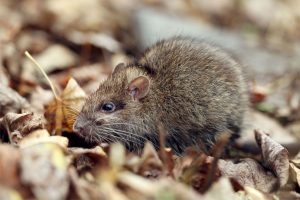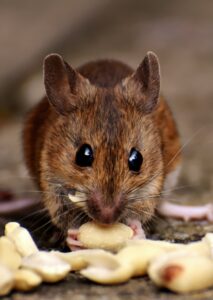
You’re pretty sure you’ve got rats in your home. The squeaking and skittering noises in the walls and attic, gnawed food boxes in the kitchen, and droppings along the walls and under furniture are all dead giveaways. The question is: what kind of rat has taken up residence?
There are 4 common types of rats in Ontario, and any one of them could have moved in and made themselves at home. In this blog, the team at Action Pest outlines what you need to know about these different rat pieces and how we can help you send them packing.
1. Brown Rat (Norway Rat)
Also known as Norway rats, the brown rat (Rattus norvegicus) is larger than most other rat species and has coarse brown or grey fur. They average eight to 10 inches in length, with their tails adding a further seven to 10 inches. Adult males weigh an average of 12 oz, while females rarely exceed 9 ounces. They are one of the common types of rats in Ontario.
Brown rats are primarily nocturnal animals. As dusk approaches, they become active in search of food and water. A higher rat population may cause some individuals to be active during daylight hours. They usually build nests in underground burrows, but while they’re in your home, they’ll usually set up camp in your walls, attic, and crawl spaces.
Breeding season typically peaks in spring and fall, while reproductive activity declines during the summer heat and can stop completely in winter. Female rats have four to six litters a year, so it doesn’t take long for a home to be completely overrun.

2. Black Rat (Roof Rat)
Also known as the roof rat, the black rat (Rattus rattus) is usually black in colour, although there are some light brown varieties with a lighter underside. They are slightly smaller than the Norway rat and have thick, scraggly fur. Adults are five to seven inches long, not including their six to nine-inch tails, and weigh anywhere from three to eight oz, depending on subspecies.
The black rat is a generalist omnivore. Their consumption of agricultural crops makes them serious pests to farmers, and inside your home, they’ll quickly chew through boxes and plastic containers to get at food. In terms of shelter, they prefer the upper parts of buildings, which is where the name ‘roof rat’ comes from.
The life cycle of a black rat is anywhere from a year to eighteen months. Breeding occurs throughout the year, but in the spring and autumn in particular. In general, females breed up to six times in their lifetime, with an average litter size of seven or eight pups. Next to the brown rat, they are one of the most common types of rats in Ontario.

3. Woodrat (Pack Rat)
The bushy-tailed woodrat (Neotoma genus), also known as a pack rat, is one of the largest and most common kinds of woodrats. They have large black eyes, big ears, and long tails. The only native rat found in Canada is called a pack rat because they tend to collect food, debris, and small objects like jewelry, coins, and can tabs.
Adult male woodrats weigh up to 21 oz and can be as long as 18 inches, while females have an average weight and length of 9 oz and 14 inches, respectively. Spring and summer are prime breeding seasons with a five-week gestation period. In a given year, a female may have one or two litters consisting of two to six offspring.
Pack rats are nest builders. Outside, they use sticks, twigs, and other plant material, but if they can get into your home, they will shred insulation, paper, mattress stuffing, and anything else tht’s convenient. They’re notorious for damaging electrical wires while looking for food sources, so the sooner you get them out, the better.

4. Marsh Rice Rat
Marsh rice rats (Oryzomys palustris) are relatively uncommon in Ontario but not unheard of. They have grey or brown fur, a white underside and feet, and measure up to five inches long. Their semi-aquatic nature means they spend a lot of time in the water. Their habitat is mostly swampy or marshy areas, but they also forage in drier places, so they’ve been known to get into homes bordering moister land.
The breeding season lasts from March to October. Each year, females can produce several litters of three to five young. Marsh rice rats build nests of grasses and sedges in hidden areas above high tide marks.
Since they prefer wet, grassy areas, marsh rice rats aren’t likely to move into your home, but they could still infiltrate the property to forage for food and nesting materials. Keeping them out means blocking off all access points into the home.

What Attracts Rats to Your Home?
The rat is an omnivore and will eat anything. Norway rats tend to prefer fatty foods, while black rats and woodrats prefer grains, seeds and nuts. Marsh rice rats prefer fish, snails, and crabs but are opportunistic feeders who will eat nearly anything. If you leave food outside in pet dishes or bird feeders, it can attract rats who may subsequently become bold enough to go inside.
Rats also prefer cluttered environments with many hiding places, which is why they often gravitate towards properties with wood piles, bushes, and other sources of immediate shelter. Once the colder months arrive, they seek warmer environments and will infiltrate buildings through gaps and openings in foundations and walls as well as around doors and windows.
There Are Many Types of Rats in Ontario! Are They in Your Home?
When you’ve got rats on your property, you’re probably more concerned about getting them out than determining what species is involved. Left unchecked, they can damage structural components of the home as well as destroy furniture, create a fire risk, and contaminate your food.
Having dealt with rat infestations in Ontario homes and businesses for over 40 years, Action Pest Control uses safe, effective methods that do not harm your family or pets. If rats decide to move in, contact us anytime for a no-obligation quote. We offer quality and effective extermination services in and around Hamilton, Burlington, and Oakville.







